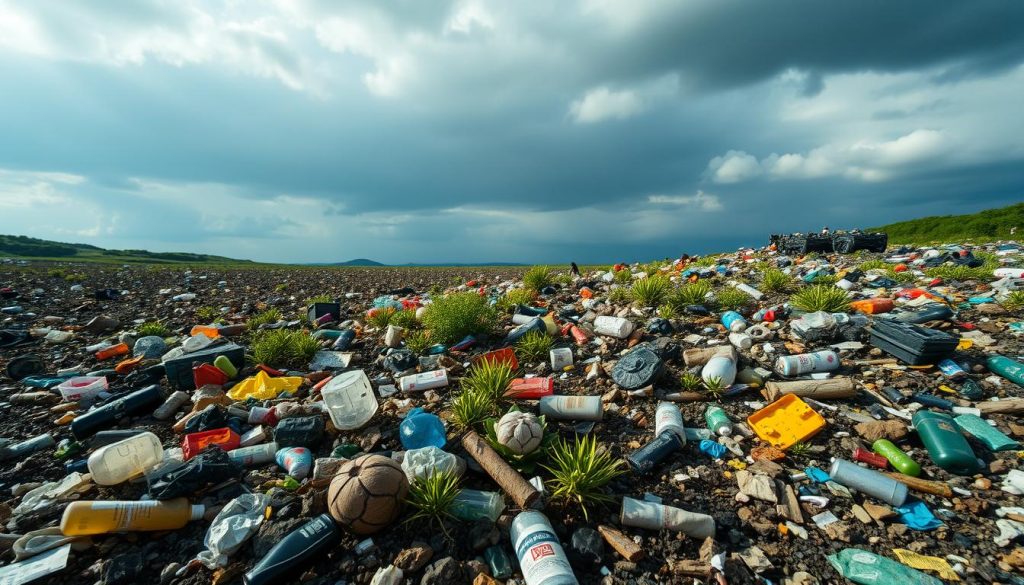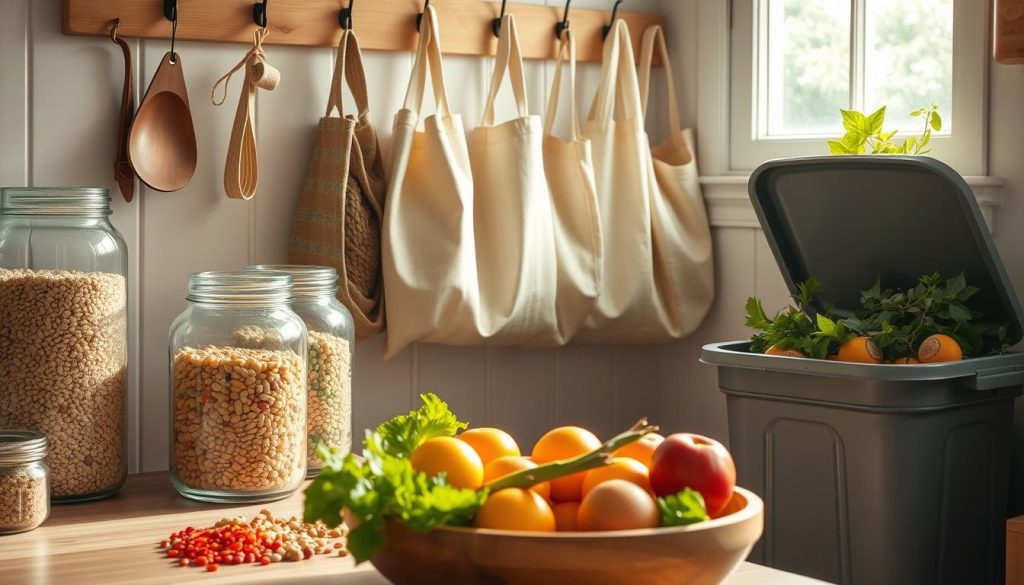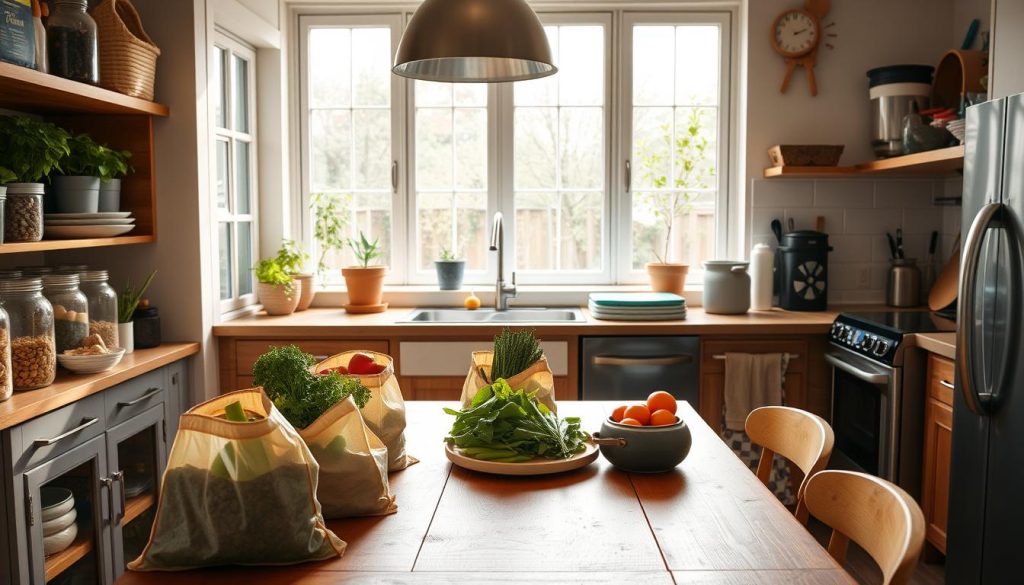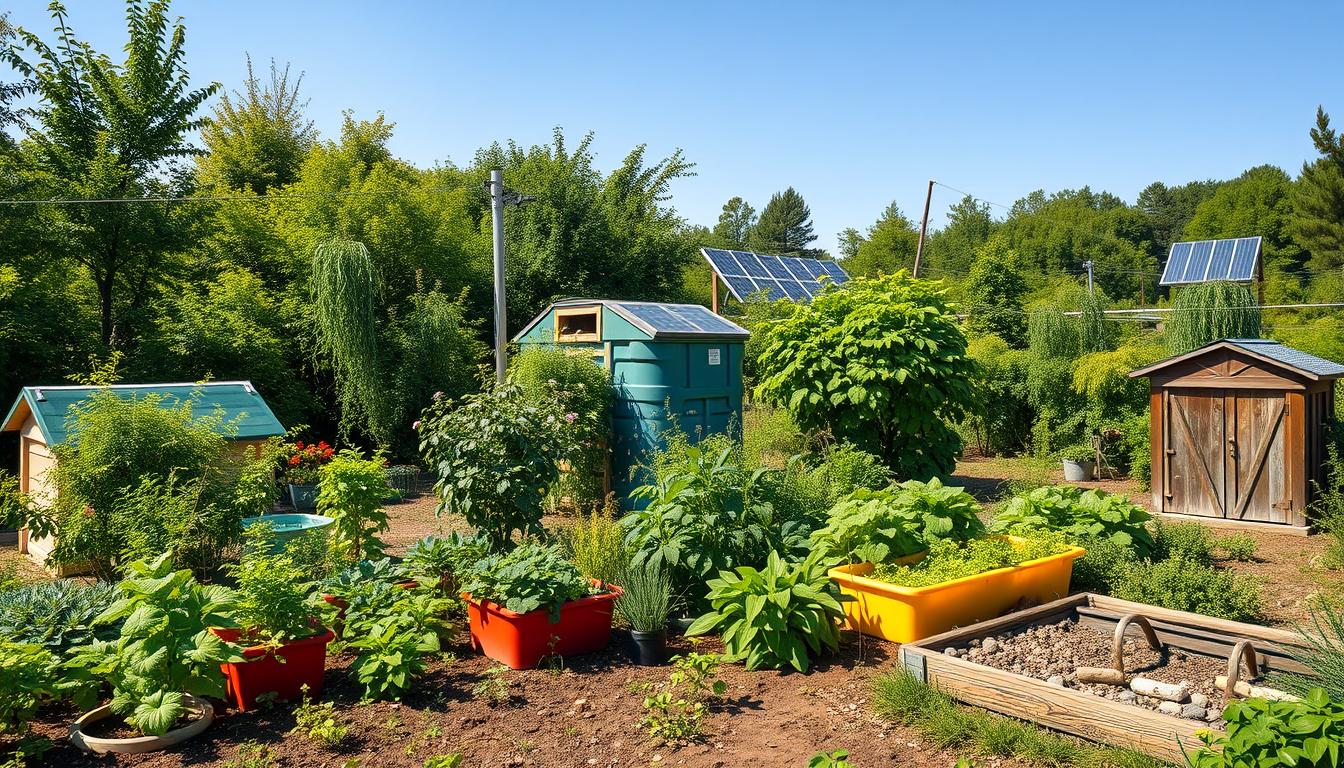I’ve been on a journey to reduce my environmental impact. I’m excited to share what I’ve learned about zero waste living. This lifestyle is all about making choices that minimize our waste and promote sustainable living.
Zero waste concepts are more than just a trend. They’re a vital shift in how we think about consumption and waste reduction. By adopting these practices, we can make a real difference in protecting our planet.
In my experience, embracing sustainable living isn’t always easy. But it’s incredibly rewarding. From refusing single-use items to finding creative ways to reuse and recycle, every small action counts towards a cleaner, greener future.
Let’s explore how we can incorporate these principles into our daily lives. Together, we can work towards a world with less waste and more sustainability.
Understanding the Zero Waste Movement
I’ve always been drawn to the Zero Waste movement and its effects on our planet. It started small but has grown into a worldwide movement. It changes how we see waste and how much we consume.
Origins and Evolution of Zero Waste
The Zero Waste movement began in the 1970s due to growing environmental worries. It started with recycling and has grown into a full plan to cut down waste. Now, it’s linked to the Circular Economy, where resources keep being used, reused, and recycled forever.
Key Principles of Zero Waste Living
Zero Waste living is based on five main ideas:
- Refuse unnecessary items
- Reduce what you buy
- Reuse and find new uses for things
- Recycle the right way
- Compost organic waste
Benefits for Individuals and the Environment
Choosing Zero Waste has many advantages. For people, it can save money and make life simpler. For the planet, it greatly cuts down on waste and saves natural resources.
| Individual Benefits | Environmental Benefits |
|---|---|
| Less money spent | Less waste in landfills |
| Life gets easier | Less greenhouse gas emissions |
| Healthier living | Natural resources saved |
By following Zero Waste principles, we can help make the future greener and our planet healthier.
The Environmental Impact of Waste

Waste is a big problem for our planet. I’ve seen how our throwaway culture hurts ecosystems and uses up valuable resources. The damage goes beyond just landfills. It also pollutes our air, water, and soil, harming wildlife and people’s health.
It’s key to save resources to fight this issue. By cutting down on waste, we save raw materials and energy. This protects natural places and the variety of life. It’s more than just recycling; it’s changing how we use things.
Climate change is also tied to waste. Landfills release methane, a strong greenhouse gas. Making single-use items also adds to carbon emissions. By going for zero waste, we can help fight climate change.
- Waste pollutes air, water, and soil
- Landfills emit harmful greenhouse gases
- Production of disposable items depletes resources
- Zero waste practices help conserve natural resources
I think knowing about these problems is the first step to change. By making smart choices every day, we can lessen our waste and protect our planet. It’s time for us all to take responsibility for the waste we make and its effects.
General Zero Waste Concepts

Zero waste living means making choices to lessen our environmental footprint. By adopting these ideas, we can significantly reduce waste in our daily lives.
Refuse: Saying No to Unnecessary Items
My zero waste journey started with refusing items I don’t need. This includes turning down free samples, promotional stuff, and single-use plastics. Declining these items has reduced clutter and waste.
Reduce: Minimizing Consumption
I only buy what I really need and choose items with little packaging. This not only cuts down on waste but also saves money.
Reuse: Finding New Purpose for Items
Before throwing something away, I think about its new use. Old jars become storage, and old clothes get used for cleaning. This creative reuse extends item lifetimes and keeps them out of landfills.
Recycle: Proper Sorting and Processing
When I can’t refuse, reduce, or reuse, I recycle correctly. Learning about local recycling has helped me sort right, ensuring efficient processing.
Rot: Composting Organic Waste
Composting is a big part of my waste reduction plan. I turn food and yard waste into soil for my garden. This keeps organic waste out of landfills and helps my plants grow.
| Zero Waste Concept | Personal Impact | Environmental Benefit |
|---|---|---|
| Refuse | Less clutter | Reduced demand for unnecessary products |
| Reduce | Cost savings | Lower resource consumption |
| Reuse | Increased creativity | Extended product lifecycles |
| Recycle | Better waste sorting habits | Efficient material recovery |
| Rot (Compost) | Free garden fertilizer | Reduced landfill methane emissions |
Sustainable Living in the Home

Starting to live more sustainably begins at home. Making small changes in our daily lives can have a big effect on the planet. Let’s look at some easy ways to make our homes more eco-friendly.
Zero Waste Kitchen Practices
The kitchen is a big source of waste in our homes. I’ve found a few ways to cut down on waste:
- Using reusable containers for food storage
- Buying in bulk to minimize packaging
- Composting food scraps
- Opting for cloth napkins instead of paper
Eco-Friendly Bathroom Solutions
The bathroom is another place where we can make big changes. I’ve made the switch to:
- Bamboo toothbrushes and compostable dental floss
- Bar soaps and shampoos to reduce plastic bottles
- Reusable cloth wipes instead of disposable ones
- Low-flow showerheads and faucets to conserve water
Minimalist Approach to Living Spaces
Living simply has been a big part of my journey towards sustainability. I focus on:
- Decluttering regularly and donating unused items
- Choosing quality, long-lasting furniture over cheap, disposable pieces
- Using natural cleaning products to reduce chemical waste
- Incorporating plants for better air quality and a connection to nature
By adopting these eco-friendly habits at home, I’ve greatly reduced my impact on the environment. I’ve also created a more mindful and peaceful living space.
Mindful Consumption: Making Eco-Conscious Choices
Mindful consumption is crucial for a zero-waste lifestyle. It means being aware of what we buy and its environmental impact. By choosing eco-friendly habits, we can greatly reduce waste.
I use the “pause and reflect” method to make better choices. Before buying, I ask if I really need it. Can I borrow or rent it? This helps me avoid buying things on impulse.
Choosing quality over quantity is also key. I spend more on durable products that last longer. This saves money and reduces waste from cheap, short-lived items.
Here’s a comparison of mindful consumption practices versus traditional shopping habits:
| Mindful Consumption | Traditional Shopping |
|---|---|
| Prioritize needs over wants | Impulse buying |
| Research product sustainability | Focus on price and convenience |
| Choose reusable options | Opt for single-use items |
| Support local, eco-friendly businesses | Shop at large chain stores |
By adopting these mindful consumption practices, I’ve found it easier to live eco-friendly. It’s not about being perfect. It’s about making choices that reflect our values and help the planet.
Zero Waste Fashion and Personal Care
Fashion and personal care can create a lot of waste. I’ve learned that living sustainably in these areas helps reduce waste and improves my health. Let’s look at some eco-friendly choices and methods that can make a big difference.
Sustainable Clothing Options
I choose quality over quantity in fashion. I look for clothes made from organic cotton, hemp, or recycled materials. Thrift stores and clothing swaps offer unique items that are good for my wallet and the planet.
Plastic-Free Beauty and Hygiene Products
I’ve made my bathroom plastic-free. I use shampoo bars, bamboo toothbrushes, and reusable cotton pads. For skincare, I’ve switched to glass containers or make my own with natural ingredients. These changes have greatly reduced my plastic waste.
Repairing and Upcycling Techniques
Learning to sew has been a big help. I can fix small tears and replace buttons, making my clothes last longer. Upcycling old t-shirts into cleaning rags or making a tote bag from jeans is fun and helps reduce waste.
- Invest in a sewing kit for quick repairs
- Watch online tutorials for upcycling ideas
- Host clothing swap parties with friends
By adopting these sustainable practices in fashion and personal care, I’ve greatly reduced my environmental impact. It’s a fulfilling journey that matches my values and encourages others to join the zero waste movement.
Implementing Zero Waste in the Workplace
Bringing General Zero Waste Concepts to work can greatly lessen our Environmental Impact. Small changes can lead to big differences in our work environment.
Going paperless is a smart move. I suggest using digital documents and tools over printing. It saves trees and keeps our office tidy.
Setting up recycling stations is also key. I’ve helped set up bins for different materials. This makes it simple for everyone to recycle right.
Using reusable items is essential. I bring my water bottle and coffee mug to work. Many colleagues do the same, reducing single-use plastics.
| Zero Waste Office Strategy | Environmental Impact | Implementation Difficulty |
|---|---|---|
| Going Paperless | High | Medium |
| Recycling Stations | Medium | Low |
| Reusable Items | High | Low |
| Energy-Efficient Appliances | High | Medium |
Lastly, promoting energy-efficient appliances and practices is important. Using LED bulbs, setting computers to sleep mode, and unplugging devices when idle helps. These actions lower our carbon footprint and energy bills.
Community Initiatives and the Circular Economy
The circular economy is growing fast as communities adopt green practices. I’ve seen how local efforts and businesses are cutting down waste and boosting recycling.
Local Zero Waste Programs
Cities are starting zero waste programs to reduce landfill use. These include curbside composting, more recycling options, and education. In my area, we have bins for food scraps that become soil for gardens.
Supporting Sustainable Businesses
I’m happy to back local businesses that focus on sustainability. Places like package-free stores and repair cafes are key to the circular economy. By picking these options, I help the environment and support eco-friendly products.
Advocacy for Policy Changes
Local efforts are pushing for laws that support zero waste goals. I’ve joined groups advocating for single-use plastic bans and rewards for circular practices. These changes are essential for growing recycling and making green choices easier for all.
Together, we can create a strong circular economy that helps our communities and the planet. Every action, from supporting recycling programs to choosing green products, moves us closer to a zero-waste future.
Overcoming Challenges in the Zero Waste Journey
Starting a zero waste journey can seem scary at first. I’ve faced many challenges while trying to live more sustainably. It’s easy to feel overwhelmed by all the changes needed.
But I’ve learned that small steps can lead to big changes. I began by changing my kitchen habits, using reusable items instead of disposable ones. Then, I moved on to the bathroom, looking for plastic-free personal care products. Taking it one step at a time has helped me build lasting habits.
Staying motivated can be hard, especially when it’s easy to fall back into old habits. I find inspiration from online zero waste communities and local groups. Sharing my journey with others keeps me going. Remember, it’s not about being perfect – it’s about making progress.
Cost can also be a challenge. Some eco-friendly products cost more upfront, but they save money in the long run. I try to reuse what I already have and make simple swaps, like using cloth napkins instead of paper. By being mindful of what I consume, I’ve found that living zero waste can actually save me money.
